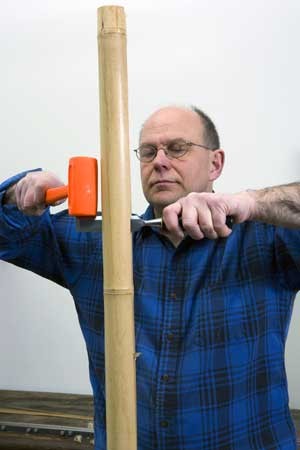Crafting a bamboo fly rod combines woodworking artistry and fly fishing passion. At CONDUCT.EDU.VN, explore resources to guide you through each step of creating your own split cane fly rod, ensuring your project aligns with ethical craftsmanship and standards. Discover the nuanced skills and precision required to construct a bamboo fly rod, from initial cane preparation to final finishing touches.
1. Understanding the Allure of Bamboo Fly Rods
Bamboo fly rods hold a special place in the hearts of anglers. Their classic aesthetic, smooth casting action, and connection to fly fishing history make them highly sought after. Unlike modern graphite or fiberglass rods, bamboo rods offer a unique feel, transmitting every subtle movement and vibration from the line and the fish. They are a testament to craftsmanship, requiring skill and patience to create.
- Historical Significance: Bamboo rods dominated fly fishing for much of the 20th century, embodying a golden age of angling.
- Superior Feel: Anglers often describe a “softer,” more connected feel compared to synthetic materials.
- Artisan Craft: Building a bamboo rod is a labor of love, showcasing both woodworking and fishing expertise.
2. Essential Tools and Materials for Bamboo Fly Rod Construction
Building a bamboo fly rod requires a specialized set of tools and high-quality materials. Sourcing the right components and investing in reliable tools will significantly impact the final product.
2.1. The Bamboo Culm: Tonkin Cane
Tonkin cane (Arundinaria amabilis) is the undisputed choice for bamboo fly rods. This specific species, grown primarily in a small region of China, possesses exceptional strength, density, and flexibility. Its long, tightly packed fibers provide the necessary power and delicate action for casting.
- Source from Reputable Suppliers: Ensure the cane is properly harvested, seasoned, and free from defects.
- Cane Selection: Look for culms with straight grain, consistent wall thickness, and minimal blemishes.
- Storage: Store the cane in a dry, well-ventilated area to prevent moisture absorption and potential warping.
2.2. Essential Tools
- Splitting Tools: Chisels or specialized splitting knives for dividing the culm into strips.
- Heat Gun: For straightening nodes and manipulating the bamboo.
- Planer: A high-quality block plane, ideally a custom-made rodmaker’s plane, for precise shaping.
- Tapering Jig (Planing Form): A crucial tool consisting of two adjustable steel bars that create the desired taper of the rod.
- Dial Calipers and Depth Gauge: Machinist’s tools for accurately measuring and setting the tapering jig.
- Glue Binder: A device for tightly wrapping the glued bamboo strips together.
- Lathe: For shaping the rod blank to accept ferrules.
- Hand Tools: Files, sandpaper, measuring tools, and other general woodworking tools.
2.3. Other Materials
- Glue: High-strength epoxy adhesive designed for bamboo rod construction.
- Thread: Upholstery thread for wrapping the rod sections during gluing.
- Ferrules: Metal sleeves that connect the rod sections.
- Grip: Cork or other material for the handle.
- Reel Seat: The component that secures the fishing reel to the rod.
- Line Guides: Metal or ceramic guides that direct the fishing line along the rod.
- Finishing Supplies: Varnish, tung oil, or other protective coatings.
- Silk Thread: For wrapping the guides onto the rod.
3. Step-by-Step Guide to Building a Bamboo Fly Rod PDF
The process of building a bamboo fly rod can be divided into three main stages: preparing the bamboo strips, shaping and gluing the strips, and finishing the rod. Each stage requires careful attention to detail and adherence to established techniques.
3.1. Stage One: Preparing the Bamboo Strips
This stage involves transforming the raw bamboo culm into precisely dimensioned strips ready for shaping.
3.1.1. Splitting the Culm
-
Select a Section: Choose a 5-foot section for the butt and another for the tip.
-
Split the Bamboo: Use chisels or splitting knives to divide the culm into six strips for the butt section and twelve for the tip. The number of strips will depend on the desired rod length and number of tips. The goal is to create strips with long, parallel strands of grain.
Alternative Text: Initial bamboo culm splitting for fly rod construction, showcasing the use of a chisel to divide the cane.
-
Remove Nodes: Use a heat gun to soften the bamboo around the nodes. Clamp the heated section in a vise to flatten the nodes. Sand any remaining bumps with 240-grit sandpaper.
Alternative Text: Bending a bamboo strip with a heat gun to remove node for fly rod creation, process of heat application shown.
3.1.2. Shaping the Strips
-
Rip to Width: Use a table saw with featherboards to rip the strips to a manageable width.
-
Plane into Triangles: Use a jig in a planer to plane the strips into triangular shapes. The jig should have 60-degree grooves.
Alternative Text: Using a planer with a jig to shape bamboo into triangles for fly rod construction, ensuring precise angles.
3.1.3. Kiln Drying
-
Dry the Strips: Kiln dry the bamboo strips to remove moisture and temper the bamboo. This can be done in a specialized oven or with a heat gun and heat ducts. Aim for about 10 minutes at 350 degrees Fahrenheit for the butt sections, less for the tips.
-
Monitor Temperature: Use thermometers to monitor the temperature during the drying process.
Alternative Text: Kiln drying setup for bamboo fly rod strips, utilizing heat ducts and a heat gun for controlled drying.
Alternative Text: A schematic diagram displaying the construction of a DIY kiln for drying bamboo strips, detailed insulation and heating elements.
3.2. Stage Two: Shaping and Gluing the Strips
This stage involves creating the precise taper of the rod and bonding the strips together to form the rod blank.
3.2.1. Setting the Tapering Jig
-
Consult a Taper Chart: Use a taper chart to determine the desired dimensions of the rod at various points along its length. A popular choice is the Everett Garrison taper.
-
Adjust the Jig: Use a depth gauge and dial calipers to precisely set the tapering jig to the dimensions specified in the taper chart. The jig consists of two steel bars that form a V-groove.
-
Zeroing Tools: Ensuring the dial caliper is correctly zeroed out is crucial for accurate measurements.
Alternative Text: Dial caliper displayed for measuring bamboo fly rod strips, tool ensuring precision in rod dimensions.
Alternative Text: Depth indicator with a pointed tip for bamboo fly rod crafting, instrument for setting planing forms accurately.
-
Test Strip: Plane a spare strip of bamboo and check its size with the calipers to ensure the jig is set correctly.
3.2.2. Planing the Strips
-
Plane Each Strip: Place each bamboo strip in the tapering jig and plane it until the plane is riding on the jig. This will create the desired taper.
-
Maintain Rind Integrity: Keep the outer face of the bamboo (the rind) against a chamfer to avoid cutting through the strong outer fibers.
-
Alternate Sides: Alternate planing between the remaining two sides to ensure the strip remains symmetrical.
-
Custom Plane: Consider using a custom-built rodmaker’s plane with a groove down the middle to prevent gouging the planing form.
Alternative Text: Using a custom plane to shape bamboo for a fly rod, tool designed with a groove for precise planing.
3.2.3. Gluing the Strips
-
Apply Glue: Spread epoxy glue evenly over all six strips.
-
Wrap with Thread: Use a glue binder to tightly wrap the glued strips together with upholstery thread. The binder applies even pressure and ensures a strong bond.
Alternative Text: Thread wrapping machine in action on bamboo fly rod sections, ensuring tight binding after gluing.
-
Binder Construction: The Garrison binder is a popular design.
-
Straighten and Cure: Straighten any twists in the wrapped rod and allow the glue to cure completely. Place the rod under weights on the planing form to keep it straight during curing.
Alternative Text: Close up view of the binder mechanism, which applies thread with even pressure.
Alternative Text: Garrison binder applying the thread to the bamboo rod blank.
3.3. Stage Three: Finishing the Rod
This final stage involves adding the hardware and applying a protective finish to the rod.
3.3.1. Attaching Ferrules
-
Prepare the Blank: Use a lathe to file down the ends of the rod blank so that the ferrules fit snugly.
-
Secure Support: Use a three- or four-jawed chuck and a support to keep the blank from whipping around.
-
Epoxy Ferrules: Epoxy ferrules onto the prepared blank.
Alternative Text: Turning bamboo on a lathe for a fly rod project, fitting the rod to the ferrule.
3.3.2. Adding Grip and Reel Seat
- Purchase Ready-Made: Buy ready-made grips and reel seats for your first few rods.
- Glue in Place: Glue the grip and reel seat onto the rod blank.
3.3.3. Applying Finish
- Select Finish: Choose a finish such as varnish or tung oil.
- Apply Finish: Apply the finish in thin coats, allowing each coat to dry completely before applying the next. Sand gently with 1,000-grit paper between coats.
3.3.4. Attaching Line Guides
-
Epoxy Tip Loop: Epoxy the loop at the tip of the rod.
-
Wrap Guides: Wrap the other guides in place with silk thread. Use a fly tying bobbin to start the wrap.
-
Secure Guides: Apply varnish to hold the silk thread in place.
Alternative Text: Securing line guides on a bamboo fly rod with silk thread, ensuring alignment and adhesion.
Alternative Text: Close up of silk thread wrapping around line guides on a fly rod, detailed craftsmanship in rod making.
Alternative Text: Applying varnish to protect the silk thread wrapping on a bamboo fly rod, final protective coat for rod longevity.
4. Optimizing Your Bamboo Fly Rod for Performance
Beyond the basic construction, several factors influence the performance of a bamboo fly rod.
- Taper Design: The taper is the single most important factor in determining the rod’s action and casting characteristics. Experiment with different tapers to find what suits your casting style and the type of fishing you do.
- Node Staggering: Stagger the nodes along the length of the rod to prevent weak spots.
- Cane Quality: Higher quality cane will result in a stronger, more responsive rod.
- Accurate Measurements: Proper measurements are essential for a professional product.
5. Ethical Considerations in Bamboo Fly Rod Making
As with any craft, ethical considerations are important in bamboo fly rod making.
- Sustainable Sourcing: Ensure that your bamboo comes from sustainably managed sources. Overharvesting can damage ecosystems and threaten the livelihoods of local communities.
- Respect for Tradition: Acknowledge the history and tradition of bamboo rod making and give credit to the pioneers who developed the techniques.
- Responsible Disposal: Dispose of waste materials responsibly and minimize your environmental impact.
6. Connecting with the Bamboo Fly Rod Community
The bamboo fly rod community is a vibrant and supportive group of anglers and craftspeople.
- Join Clubs and Organizations: Connect with other rod makers and share your knowledge and experiences.
- Attend Workshops and Seminars: Learn from experienced rod makers and refine your skills.
- Online Forums and Communities: Participate in online discussions and share tips and advice.
7. Troubleshooting Common Problems
Building a bamboo fly rod is a challenging process, and it is likely that you will encounter some problems along the way.
- Strip Alignment: Ensure that the strips are perfectly aligned before gluing.
- Glue Gaps: Fill any gaps in the glue with additional epoxy.
- Warping: Straighten warped sections with heat and pressure.
- Finish Imperfections: Sand out imperfections in the finish and apply additional coats.
8. Maintaining Your Bamboo Fly Rod
A well-cared-for bamboo fly rod can last for generations.
- Clean After Use: Wipe down the rod with a soft cloth after each use.
- Store Properly: Store the rod in a rod tube in a cool, dry place.
- Regular Inspection: Inspect the rod regularly for any signs of damage.
- Professional Repair: If you encounter any serious problems, take the rod to a qualified repair shop.
9. The Future of Bamboo Fly Rods
While modern materials like graphite and fiberglass have become more prevalent, bamboo fly rods continue to hold a special appeal.
- Renewed Interest: There is a growing interest in traditional crafts and sustainable materials, which has led to a resurgence in bamboo rod making.
- Innovation: Rod makers are constantly innovating and developing new techniques to improve the performance and durability of bamboo rods.
- Timeless Appeal: The classic aesthetic and unique feel of bamboo rods will continue to attract anglers for years to come.
10. Expanding Your Knowledge of Bamboo Fly Rod Construction
Dive deeper into the art of crafting bamboo fly rods with these expert resources.
- Everett Garrison and Hoagy Carmichael – A Master’s Guide to Building a Bamboo Fly Rod: Considered the bible of bamboo rod making.
- Books: Seek out other books and articles on bamboo rod making.
- Online Resources: Explore online forums, videos, and tutorials.
11. Five Intentions to Master Bamboo Fly Rods
Understanding the motivations behind learning to build bamboo fly rods helps tailor resources effectively.
- Crafting a Unique Fishing Tool: The desire to create a personalized fly rod that reflects individual style and preferences.
- Connecting with Fly Fishing History: An appreciation for the tradition and heritage of bamboo fly rods.
- Achieving Superior Casting Performance: The pursuit of a rod with a specific action and feel for optimal casting.
- Enjoying the Craftsmanship Process: Finding satisfaction in the meticulous process of hand-building a functional work of art.
- Building a Sustainable and Heirloom Quality Rod: Creating a rod that will last for generations and minimize environmental impact.
12. Comply with CONDUCT.EDU.VN
Understanding and adhering to regulations and ethical considerations in any field is crucial.
- Ethical Craftsmanship: Upholding standards of honesty, integrity, and respect for tradition in rod making.
- Environmental Responsibility: Sourcing sustainable materials and minimizing waste.
- Compliance with Regulations: Adhering to any applicable laws or regulations related to the sourcing, sale, or use of bamboo or other materials.
13. Contact CONDUCT.EDU.VN Today
For further information on ethical conduct and guidelines in various fields, visit CONDUCT.EDU.VN or contact us at 100 Ethics Plaza, Guideline City, CA 90210, United States. You can also reach us via Whatsapp at +1 (707) 555-1234.
CONDUCT.EDU.VN is your reliable resource for understanding and implementing ethical standards.
FAQ: Bamboo Fly Rod Building
- What is Tonkin cane and why is it used for bamboo fly rods?
Tonkin cane is a specific species of bamboo with exceptional strength, density, and flexibility, making it ideal for fly rods. - What tools are essential for building a bamboo fly rod?
Essential tools include splitting tools, a heat gun, a planer, a tapering jig, dial calipers, a glue binder, and a lathe. - What is a tapering jig and how is it used?
A tapering jig (planing form) is a tool consisting of two adjustable steel bars that create the desired taper of the rod. - Why is it important to kiln dry the bamboo strips?
Kiln drying removes moisture and tempers the bamboo, resulting in a stronger, more responsive rod. - What type of glue should I use for building a bamboo fly rod?
High-strength epoxy adhesive designed for bamboo rod construction is recommended. - What is a glue binder and how does it work?
A glue binder is a device that tightly wraps the glued bamboo strips together with upholstery thread, ensuring a strong bond. - How do I attach the ferrules to the rod blank?
Use a lathe to file down the ends of the rod blank so that the ferrules fit snugly, then epoxy them in place. - What type of finish should I use on my bamboo fly rod?
Varnish or tung oil are common choices. Apply thin coats and sand gently between coats. - How do I attach the line guides to the rod?
Wrap the guides in place with silk thread and secure them with varnish. - How do I maintain my bamboo fly rod?
Clean the rod after each use, store it properly, and inspect it regularly for damage.
By following these steps and guidelines, you can embark on the rewarding journey of building your own bamboo fly rod. Remember to prioritize ethical considerations and seek guidance from experienced rod makers along the way. Visit conduct.edu.vn for more resources and information.


